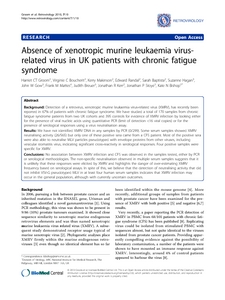Groom, HC;
Boucherit, VC;
Makinson, K;
Randal, E;
Baptista, S;
Hagan, S;
Gow, JW;
Mattes, FM;
Breuer, J;
Kerr, JR;
et al.
Groom, HC; Boucherit, VC; Makinson, K; Randal, E; Baptista, S; Hagan, S; Gow, JW; Mattes, FM; Breuer, J; Kerr, JR; Stoye, JP; Bishop, KN
(2010)
Absence of xenotropic murine leukaemia virus-related virus in UK patients with chronic fatigue syndrome.
RETROVIROLOGY, 7 (10).
ISSN 1742-4690
https://doi.org/10.1186/1742-4690-7-10
SGUL Authors: Kerr, Jonathan Richard
![[img]](https://openaccess.sgul.ac.uk/2589/1.hassmallThumbnailVersion/1742-4690-7-10.pdf)  Preview |
|
["document_typename_application/pdf; charset=binary" not defined]
Published Version
Download (624kB)
| Preview
|
Abstract
BACKGROUND: Detection of a retrovirus, xenotropic murine leukaemia virus-related virus (XMRV), has recently been reported in 67% of patients with chronic fatigue syndrome. We have studied a total of 170 samples from chronic fatigue syndrome patients from two UK cohorts and 395 controls for evidence of XMRV infection by looking either for the presence of viral nucleic acids using quantitative PCR (limit of detection <16 viral copies) or for the presence of serological responses using a virus neutralisation assay.
RESULTS: We have not identified XMRV DNA in any samples by PCR (0/299). Some serum samples showed XMRV neutralising activity (26/565) but only one of these positive sera came from a CFS patient. Most of the positive sera were also able to neutralise MLV particles pseudotyped with envelope proteins from other viruses, including vesicular stomatitis virus, indicating significant cross-reactivity in serological responses. Four positive samples were specific for XMRV.
CONCLUSIONS: No association between XMRV infection and CFS was observed in the samples tested, either by PCR or serological methodologies. The non-specific neutralisation observed in multiple serum samples suggests that it is unlikely that these responses were elicited by XMRV and highlights the danger of over-estimating XMRV frequency based on serological assays. In spite of this, we believe that the detection of neutralising activity that did not inhibit VSV-G pseudotyped MLV in at least four human serum samples indicates that XMRV infection may occur in the general population, although with currently uncertain outcomes.
| Item Type: |
Article
|
| Additional Information: |
© 2010 Groom et al; licensee BioMed Central Ltd. This is an Open Access article distributed under the terms of the Creative Commons Attribution License (http://creativecommons.org/licenses/by/2.0), which permits unrestricted use, distribution, and reproduction in any medium, provided the original work is properly cited. |
| Keywords: |
Adolescent, Adult, Aged, Antibodies, Viral, Cohort Studies, DNA, Viral, Fatigue Syndrome, Chronic, Female, Great Britain, Humans, Male, Middle Aged, Neutralization Tests, Polymerase Chain Reaction, Retroviridae, Retroviridae Infections, Young Adult, Science & Technology, Life Sciences & Biomedicine, Virology, PROSTATE-CANCER, INFECTIOUS RETROVIRUS, XMRV, ANTIBODIES, TUMORS, ASSAY |
| Journal or Publication Title: |
RETROVIROLOGY |
| ISSN: |
1742-4690 |
| Related URLs: |
|
| Web of Science ID: |
WOS:000275694200001 |
  |
Download EPMC Full text (PDF)
|
 |
Download EPMC Full text (HTML)
|
| URI: |
https://openaccess.sgul.ac.uk/id/eprint/2589 |
| Publisher's version: |
https://doi.org/10.1186/1742-4690-7-10 |
Statistics
Item downloaded times since 01 May 2012.
Actions (login required)
 |
Edit Item |



